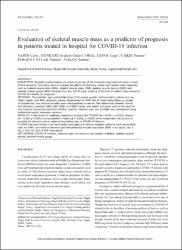Evaluation of skeletal muscle mass as a predictor of prognosis in patients treated in hospital for COVID-19 infection

View/
Date
2022Author
Şahin, CemYeniçeri, İbrahim Önder
Oral Tapan, Özge
Çakır, Tümay
Dirgen Çaylak, Selmin
Toğan, Turhan
Metadata
Show full item recordAbstract
SUBJECTIVE: Skeletal muscle indexes are known to be one of the important prognostic indicators in many clinical situations. This study aims to evaluate the effects of laboratory values and muscle mass measures such as skeletal muscle area (SMA), skeletal muscle index (SMI), skeletal muscle density (SMD) and skeletal muscle gauge (SMG) obtained from the 12th thoracic vertebra (T12) level of patients hospitalized for COVID-19 infection on prognosis.
METHODS: The patients\' age, comorbidity index (CCI) scores, gender, anthropometric criteria such as height, weight, and BMI, laboratory values, development of NIMV and IC need during follow-up, length of hospital stay, and hospital mortality were retrospectively screened. The relationship between clinical and laboratory variables, SMA, SMI, SMD, and SMG values, and patient outcomes such as the need for non-invasive mechanical ventilation (NIMV), need for intensive care, and mortality was investigated using multivariate logistic regression analysis.
RESULTS: It was shown in multilinear regression analysis that T12SMD (beta=-0.254; p= 0.036), albumin (beta=-0.465; p= 0.005), and procalcitonin values (beta=-0.292; p= 0.026) were independent risk factors on mortality for intensive care in patients hospitalized due to COVID-19 infection.
T12SMD has been shown to be significantly associated with various negative outcomes such as mortality, need for NIMV, and need for intensive care independently of body mass index (BMI) in our study (Tab. 5, Fig. 2, Ref. 25). Text in PDF www.elis.s

















